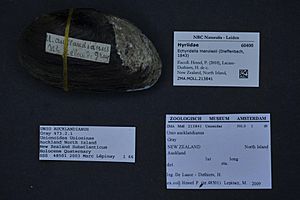New Zealand freshwater mussel facts for kids
Quick facts for kids New Zealand freshwater mussel |
|
|---|---|
 |
|
| Scientific classification | |
| Kingdom: | |
| Phylum: | |
| Class: | |
| Order: |
Unionida
|
| Family: |
Unionidae
|
| Genus: |
Echyridella
|
| Species: |
E. menziesii
|
| Binomial name | |
| Echyridella menziesii (Gray, 1843)
|
|
| Synonyms | |
|
|
Echyridella menziesii, also known as the New Zealand freshwater mussel, is a special type of mussel. It has Māori names like kākahi, kāeo, and torewai. This mussel lives only in New Zealand's fresh waters. It is an aquatic bivalve mollusc, part of the river mussel family called Unionidae.
Long ago, Māori used these mussels as an important food source. Today, these mussels are in danger. Things like pollution, too many nutrients in rivers (called eutrophication), and new fish species are harming them. People are working to protect them.
Where They Live
These mussels used to be very common. You could find them in lakes, rivers, and streams all over New Zealand.
How They Grow: Life Cycle
New Zealand freshwater mussels have a unique way of reproducing. Their babies, called glochidia, are tiny larvae. These larvae need a special "host" fish to grow up. They attach themselves to a fish for a short time. During this time, they change and grow into young mussels. The most common host fish for these mussels is the kōaro (Galaxias brevipinnis).
What Harms Them
Many things can cause the number of New Zealand freshwater mussels to drop. When their homes in rivers and lakes are destroyed or changed, it hurts them. This can happen because of pollution or changes to the water. These changes also harm the kōaro fish, which the mussels need to grow.
Protecting Them
The New Zealand freshwater mussel needs help to survive. In May 2014, the Department of Conservation looked at their status. They classified the mussel as "At risk" and "declining" under the New Zealand Threat Classification System. This means their numbers are going down, and they need protection. People are working to keep their habitats clean and safe.

